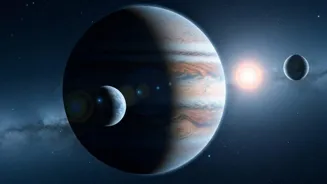Unveiling the Secrets of Telescopes: Explore the Technology Behind Astronomy's Magic Tools. Read More to Dive Deeper!
Have you ever looked up at the night sky and wondered about the twinkling stars and distant
planets? Telescopes are the magic tools that allow us to see these celestial wonders in greater detail.

These instruments, ranging from simple backyard models to massive observatories perched on mountaintops, have revolutionized our understanding of the universe. But how exactly do these marvels of engineering work?
Let's take a closer look at the technology behind telescopes and how they help us explore the cosmos.
Telescopes gather light and magnify distant objects for astronomy
Telescopes serve two primary functions: to gather more light than our eyes can and to magnify the image of distant objects. Think of it like this: our eyes are like tiny buckets collecting light. The bigger the bucket, the more light it can catch.

A telescope acts as a much larger bucket, gathering significantly more light from faint, far-off objects. This allows us to see objects that are too dim to be visible with the naked eye.
As for magnification, telescopes use lenses or mirrors to bend light, making objects appear larger than they would normally. This combination of light-gathering and magnification is what makes telescopes so powerful for astronomical observation.
Two main types of optical telescopes: refracting and reflecting telescopes
There are primarily two main types of optical telescopes: refracting telescopes and reflecting telescopes. Refracting telescopes use lenses to bend and focus light, much like a magnifying glass. The first lens, called the objective lens, is large and collects light from a distant object.

This lens bends the light rays, bringing them to a focal point. An eyepiece lens then magnifies this focused image, allowing the observer to see it clearly. However, refracting telescopes have some limitations.
Large lenses can be difficult and expensive to manufacture, and they can suffer from chromatic aberration, which causes colored fringes around objects.
Reflecting telescopes use mirrors to focus light, overcoming refracting telescopes' limitations
Reflecting telescopes, on the other hand, use mirrors to collect and focus light. The primary mirror, which is concave, is the largest and most important component. It reflects incoming light rays towards a focal point.

A secondary mirror then redirects the light to the eyepiece, where it is magnified. Reflecting telescopes overcome many of the limitations of refracting telescopes. Mirrors are easier and cheaper to manufacture in large sizes, and they do not suffer from chromatic aberration.
This is why most professional telescopes are reflecting telescopes. The largest telescopes in the world, such as the James Webb Space Telescope, are reflecting telescopes.
telescopes detect various electromagnetic radiation for deeper space study
Beyond optical telescopes, which collect visible light, there are telescopes that detect other forms of electromagnetic radiation. For example, radio telescopes collect radio waves emitted by celestial objects.

These telescopes typically consist of a large dish antenna that focuses radio waves onto a receiver. Radio telescopes can detect signals from objects that are too faint or obscured by dust for optical telescopes to see.
Similarly, there are infrared telescopes, ultraviolet telescopes, X-ray telescopes, and gamma-ray telescopes, each designed to detect a specific part of the electromagnetic spectrum.
By studying the universe across the entire spectrum, astronomers can gain a more complete understanding of celestial objects and phenomena.
Revolutionary JWST telescope explores universe's origins
The James Webb Space Telescope (JWST), for instance, is a revolutionary infrared telescope that orbits the sun. Its infrared capabilities allow it to peer through clouds of dust and gas to observe the earliest galaxies and stars forming in the universe.

The use of cutting-edge technology allows us to gain images from the depth of space that can take us further back in time and give us more knowledge of how our universe came to be. Telescopes has helped in understanding the laws of physics and the behaviour of celestial objects.
From the planets of our solar system to distant galaxies billions of light-years away, telescopes have opened up a window to the universe, allowing us to glimpse its beauty and complexity.
As technology continues to advance, telescopes will undoubtedly play an even greater role in our quest to understand the cosmos.












